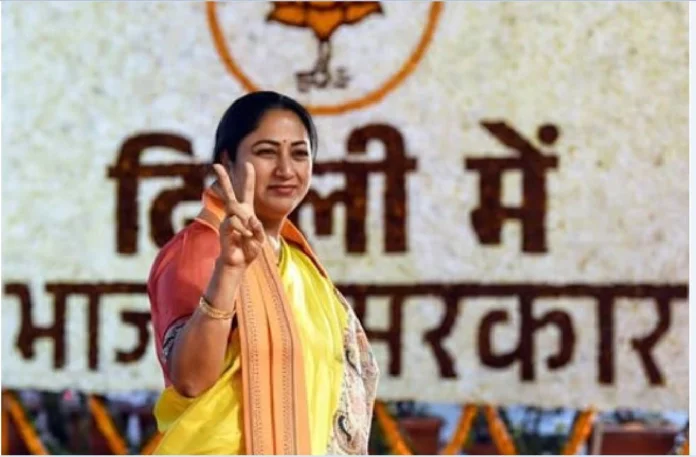By India Legal Correspondent
When Rekha Gupta’s name was announced as chief minister of Delhi, the city’s women erupted in celebration. It was not just a political victory; it was a symbolic moment of woman power triumphing over caste, community, and even competence in the eyes of many. Across the capital, women lauded Prime Minister Narendra Modi and his team for giving Delhi a female leader, a move that resonated with the BJP’s broader focus on women-centric governance.
It was no surprise, then, that thousands of women flocked to the historic Ramlila Maidan to witness Gupta’s swearing-in. But as the initial euphoria settled, a glaring contradiction emerged—Delhi’s new woman chief minister was leading an all-male cabinet.
A Lone Woman Among Men
The expectation had been that Gupta’s appointment would pave the way for increased female representation in Delhi’s governance. Instead, her cabinet dashed those hopes. The six ministers chosen—Manjinder Singh Sirsa, Ashish Sood, Ravinder Indraj Singh, Kapil Mishra, Pankaj Kumar Singh, and Parvesh Verma—were all men. Even the Speaker of the assembly post went to Vijender Gupta, a three-time MLA from Rohini.
While few expected an all-woman cabinet, the lack of even a token female minister was disappointing. The BJP’s much-touted emphasis on gender representation seemed to end with Gupta herself.
Caste, Community, And Calculated Choices
If gender did not influence cabinet selections, caste and community clearly did. Each minister ticks a strategic electoral box:
- Manjinder Singh Sirsa: Delhi’s richest MLA with declared assets of Rs 248 crore, was chosen to appease the Sikh community. His role as former president of the Delhi Sikh Gurdwara Management Committee bolstered his claim.
- Pankaj Kumar Singh: A Purvanchali and a Thakur, caters to Delhi’s 30 percent Purvanchali voters, who had played a key role in AAP’s previous victories, but shifted allegiance to the BJP this time. His RSS background also worked in his favour.
- Ashish Sood: A Punjabi face, he enjoys close ties with BJP President JP Nadda and Union Minister Dharmendra Pradhan. The Punjabi vote bank, which largely backed the BJP, won 17 out of 20 Punjabi-dominated constituencies in Delhi.
- Ravinder Indraj Singh: A Dalit representative, and Kapil Mishra, a Brahmin leader, further balanced the caste equation.
One man, however, stood out—not for his selection, but for his conspicuous dissatisfaction.
Parvesh Verma: The Sulking Giant Slayer
Among the six ministers, Parvesh Verma was the only one who appeared anything, but triumphant. Having defeated Arvind Kejriwal, he was hailed as a giant slayer. His credentials also included being the son of former Delhi Chief Minister Sahib Singh Verma—a legacy he frequently brandished.
Yet, Verma was overlooked for the top job, with Gupta taking centre stage instead. His body language during the swearing-in and the subsequent aarti on the banks of the Yamuna suggested visible resentment. Speculation about him being made deputy chief minister remained unconfirmed at the time of going to press. If it materialized, it would merely be a consolation prize for someone who saw himself as the natural heir to Delhi’s throne.
The situation echoed the case of Smriti Irani in 2019, when her victory over Rahul Gandhi in Amethi led supporters to expect a major cabinet portfolio at the centre. Instead, she was given the ministry of women and child development—considered a soft ministry within the power hierarchy.
Gupta now faces not just governance challenges, but also managing the heartburn of sidelined leaders like Verma.
The Modi Doctrine And Women-Centric Politics
Rekha Gupta’s rise fits into the broader narrative of Prime Minister Narendra Modi’s push for women’s empowerment. His first Independence Day speech in 2014 famously emphasized the need for toilets in every rural household, an issue many mocked at the time. Since then, the Modi government has launched several women-centric schemes—providing free gas cylinders, financial assistance to women, and housing schemes where ownership is registered in a woman’s name.
The BJP’s Delhi campaign also leaned heavily on gender, promising monthly financial aid for women, free bus travel, and nutritional kits for pregnant women. Gupta, as a female chief minister, is the face of these promises.
Hitting The Ground Running
If optics played a role in Gupta’s elevation, her first hours in office signalled an intent to deliver. Within hours of taking over, she convened her first cabinet meeting and made key announcements:
- Tabling 14 CAG reports in the first assembly session.
- Implementing the centre’s flagship health insurance scheme.
- Rolling out the promised financial assistance to women by March 8, International Women’s Day—a symbolic move reinforcing her pro-women agenda.
A Historic Milestone, But Challenges Lie Ahead
Gupta is now the second female chief minister in India after Mamata Banerjee and Delhi’s ninth chief minister across genders. However, within the BJP, she is only the second woman to hold this post after Sushma Swaraj.
For the BJP, her appointment marks a triumphant return to power in Delhi after 27 years. But the road ahead is fraught with political manoeuvring, factional discontent, and the pressure to deliver on ambitious promises.
Will Rekha Gupta rise to the challenge, or will her gender-driven elevation prove to be a strategic move with little lasting impact? The answer lies in how well she navigates governance, dissent, and expectations in the days ahead.


